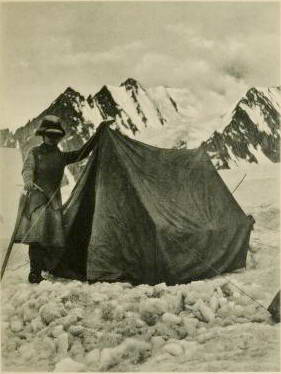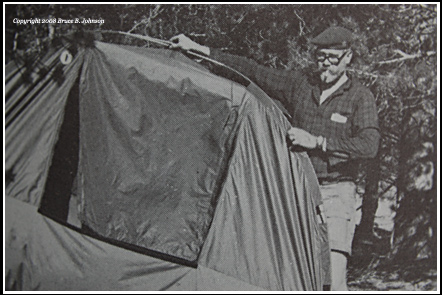Vintage
Tents by the History of Gear Project
A very
brief overview
What kind of tents/fabrics/designs did
the early expeditionary climbers and explorers use? Nylon, the
key modern fabric, was not invented until 1935, patented in 1938,
but did not enter consumer gear manufacturing until just after
WW II, with companies such as Holubar
Mountaineering and GERRY Mountain Sports.
The "Whymper Tent." In 1862
the famed British climber Edward Whymper (1840-1911) devised a
tent that was to see wide use and many variations/improvments
over many decades. His original tent was an big, 4-man A-frame,
with two crossed poles and a climbing rope as a ridgeline, all
canvas, with a floor, and really heavy, over 22 pounds, and that
was when it was dry! A modified version of this called the Meade
was used in 1924 by the ill-fated climbers Mallory
and Irvine on Mt. Everest. Whymper's climbing credentials
included the first ascent of the Matterhorn. The Whymper tents
were seen in English catalogs as late as 1960!
During the Civil War, Union commanders
gave soldiers tarps for shelter, which soldiers could stretch
between two rifles, thus making a "pup tent." The naming
was derisive, the tents were so small and miserable that soldiers
would say grown dogs couldn't fit, only pups! And in my early
days as a Boy Scout, indeed our pup tents were dark, cramped,
leaked, let in bugs, and worse.
The "Mummery" tent was the
lightweight climber's tent of the time: it was another pup tent,
but dramatically lighter, in significant ways similar to modern
ultralight tarps using hiking poles for support.  Mummery
tents used oiled silk for fabric and two ice axes (alpenstocks)
for support, and various guy ropes and tent stakes as needed.
The design was floorless, but usualy a separate ground sheet was
used. Fred Mummery (1855-1895) came out with his tents some 20
years after Whymper.
Mummery
tents used oiled silk for fabric and two ice axes (alpenstocks)
for support, and various guy ropes and tent stakes as needed.
The design was floorless, but usualy a separate ground sheet was
used. Fred Mummery (1855-1895) came out with his tents some 20
years after Whymper.
The Mummery design was in use when Mummery,
a well-known mountaineer, attempted Nanga Parbat in 1895, and
died there at age 40 in an avalanche without reaching the peak,
which was not climbed until 1953. The tent itself, in various
sizes and other fabrics like canvas, continued in use up until
around 1950, when strong designs in nylon like the GERRY
Himalayan tent soon superseded it, the GERRY tent was used
in Edmund Hillary's famous climb of Mt. Everest in 1953, but so
were some 2-man Whymper-Meade tents for the higher camps.. It
was the crossover moment of the old and new in the history of
gear. The Mummery, Whymper and Meade tents were beginning to pass
into history. Ahead was a mighty wave of new tent designs and
yet-to-be-invented space age fabrics.
Our illustration is from the Karakoram
in 1908, showing a woman who gained some fame, Fanny Bullock Workman.
She's standing beside her modified Mummery tent. The design details
are not apparent, but clearly it's supported by much more than
just two ice axes!
WHO GETS CREDIT FOR THE
FIRST "DOME TENT" ???
 History
of Gear Credit #1 --First modern "Dome Tent" with modern
nylons and bent poles. This was well before the famous Jansport
dome tents came on the market in about 1971.
History
of Gear Credit #1 --First modern "Dome Tent" with modern
nylons and bent poles. This was well before the famous Jansport
dome tents came on the market in about 1971.
"The Dome Tent. We, at A16, called
it the "A16 Dome Tent." Real original name! (when you
are first, you can call it anything you want!)... It was made
in a two and four man version. ..Did I invent it? I prefer to
describe it as "innovation." Every thing had been around
in one form or another. I just reassembled them in a new concept.
The concept of bent poles was first produced by "Thermos."
Yes, the "Thermos Bottle" people. Their version was
made of cotton. The poles were solid fiberglass rods with aluminum
tube sleeves as joints. A two man version weighed over 11 pounds.
The poles were sprung up inside the tent canopy, on diagonal corners.
The side door was zippered over the full curve of the tent. Thermos
promoted it as a backpacking tent, but it was a small tent, and
too much weight."..... EDITOR: the famed tent designer/guru
Bill Moss is credited on the Bill Moss website with designing the Pop Tent in 1955, and
licensing it to King Seeley/Thermos by 1959-60. The Pop Tent was
certainly a "dome tent," but acros the Pacific, a company
named Croster
in Japan claims that they invented the "World's First"
dome tent in 1959. My vote probably goes to Bill Moss, based on
the information I've been able to amass.
Back to Andy Drollinger-- "In the
early 1950s, the old timers such as Thermos and Coleman had to
be dragged scratching and fighting away from cotton and into synthetics
[eg. [nylon fabrics]. After all, they were the Kings. No new innovations
in their empires."
"The Birth of the A16 Dome Tent:
Somehow or other, I crossed paths with Jack
Stephenson of Warmlite, another early lightweight tent maker
[using a space-age design called the
elliptical arc]. He lived in Northridge, CA [fairly near Mr.
Drollinger]....He used waterproof coated two ounce [nylon] fabric
with his poles on the inside. Easton Aluminum made Jack's poles
by draw-forming. No rain fly, so he provided a mickey mouse vent
hole in the top to get rid of body accumulated moisture..."
(Note 1: Easton Aluminum Company is better-known for producing
the first aluminum baseball bats! It's owner Jim Eastman was a
friend of both Drolinger and Stephenson. Note #2: Wayne Gregory
remembers both Drolinger and Stephenson attending a Sierra Club
function in Balboa Park in 1965, as fellow vendors. Note: if you
need a tent pole repair, one of Easton's original employees runs
a pole company in Vancouver, WA, "Tent
Pole Technologies." It's owner has done several great
repairs for me.Easton
tent poles
"I took a step back to the old cotton
tents with an external covering rain fly. I made the tent from
breatheable nylon... the poles were on the outside of the tent,
held up the tent, and were covered with the rainfly...the original
poles were hollow arrow shafts...This was the original use
of bent poles to hold up the tent form and make a breathing space
clearance between the tent canopy and the fly."
An interesting sidelight into the world
of Patenting is recalled, "At A16 I received a letter from
a lawyer telling me to cease and desist in using the segmented
tent poles in the dome tents. His client had filed a patent for
a portable radar reflector using similar poles...I chose to ignore
him and I didn't hear from him again."
Regarding a special version of the A16
Dome made with all-mosquito netting canopy under the waterproof
fly: "[We sold the tent] to game rangers in the elephant
areas of Africa. They loved it! The elephants thought they were
big rocks and wouldn't step on them. Inside the bug-proof tent
it was like sleeping on a screen porch!"
Note: by the time of the 1975 A16 catalog,
this original dome was being called the "Half-Dome,"
and came in 2 1/2 or 4 person versions. A key design feature was
the "spring alloy aluminum poles." Weight was 5 1/2
pounds for the "2 1/2" person version. Prices were $179
and $199... The A16 company had grown to a staff of 24 people,
headed by Mic Mead. (added note: Mr. Drollinger left A16 during
the early 1970s).
See below for History
of Gear books!
Please Note: All Material here, and in all my "History
of Gear" webpages, is copyrighted, and no usage of my material
is permitted unless explicit permission is granted by me, Bruce
B. Johnson, owner of OregonPhotos.com. ...The images are reworked
scans of Mr. Drollinger's copy of a 288 page book he helped create
named "The
Backpacker's Digest" with his friend C.R. Learn and Anne S. Tallman
..... Note: if you were involved
with one of the old-line, vintage gear companies and have a story
to tell in these pages, please contact me soon.... Disclaimer: The material on this
page represents only the reports of the correspondents and my
own interpretation of those reports. In many cases "History
of Gear" material is difficult to independently verify and
that is a "given" in this type of research. It is important
to keep in mind that the events, gear, and personages reported
in the "History of Gear" lie far in the past, in some
cases as much as 60 years in the past. It is common that even
people who were within the same company so many years ago will
remember/interpret happenings in quite different ways.
Remarkably different has been the business
course of the small custom gearmaker Stephenson's
Warmlite, which has survived, and never changed its name or
ownership in some 50 years of doing business! Up until recently,
even its Business Manager was unchanged! Update: Jack Stephenson
passed away in early 2017. Warmlite was bought by his niece Kim
Stephenson Cunningham, who is busy re-establishing it in Fort
Collins, Colorado (April 2019 news).
BOOK ALERTS: My
first book in a series about The History of Gear was about Frostline
Kits. Please visit my FROSTLINE PAGE (click here) for a link to order it, or to view a free 15 page
PDF preview. The second book was released May 20, 2008 and is
titled, "GERRY, To Live in the Mountains" (click here). The third book of the series was released in November
2009 and covers the story of Holubar Mountaineering.
Since that time, I have published two additional books, one about
Mountain Safety Research of Seattle (MSR), and the other about
Stephenson's Warmlite Equipment....Later, I will pull together
several of the smaller gear companies into one book, among them
will be A16...... Please
Note that my six books
are also available as inexpensive PDF downloads ($15 apiece, direct
from me, contact: oldgear@Oregonphotos.com)

Page last revised 05/28/2022
 Mummery
tents used oiled silk for fabric and two ice axes (alpenstocks)
for support, and various guy ropes and tent stakes as needed.
The design was floorless, but usualy a separate ground sheet was
used. Fred Mummery (1855-1895) came out with his tents some 20
years after Whymper.
Mummery
tents used oiled silk for fabric and two ice axes (alpenstocks)
for support, and various guy ropes and tent stakes as needed.
The design was floorless, but usualy a separate ground sheet was
used. Fred Mummery (1855-1895) came out with his tents some 20
years after Whymper. History
of Gear Credit #1 --First modern "Dome Tent" with modern
nylons and bent poles. This was well before the famous
History
of Gear Credit #1 --First modern "Dome Tent" with modern
nylons and bent poles. This was well before the famous